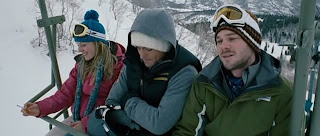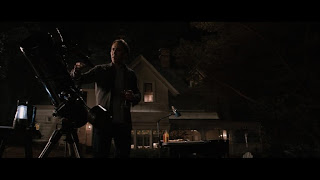 Early in Darren Aronofsky’s stone-cold modern classic ‘Black Swan’, impresario Tomas Leroy (Vincent Cassel) offers a 72-word synopsis of Tchaikovsky’s eternally popular ballet ‘Swan Lake’:
Early in Darren Aronofsky’s stone-cold modern classic ‘Black Swan’, impresario Tomas Leroy (Vincent Cassel) offers a 72-word synopsis of Tchaikovsky’s eternally popular ballet ‘Swan Lake’:
“We all know the story. Virginal girl, pure and sweet, trapped in the body of a swan. She desires freedom but only true love can break the spell. Her wish is nearly granted in the form of a prince, but before he can declare his love her lustful twin, the black swan, tricks and seduces him. Devastated the white swan leaps of a cliff killing herself and, in death, finds freedom.”
Leroy’s intent is for his ailing ballet company to present a new version of ‘Swan Lake’. Although he admits that “it’s been done to death”, his idea is to “strip it down, make it visceral”. With prima ballerina Beth Macintyre (Winona Ryder) retiring from the company under a storm of bad feeling, Leroy also intends on using ‘Swan Lake’ as the debut of his next leading lady. Tensions are running high as the ballerinas vie for the role.
While Leroy delivers the above synopsis, he walks among the ranks, all of them primping and preening and trying to catch his attention as they practice at the barre. He steps some of the women on shoulder. They beam with smug superiority. After he concludes his address, Leroy instructs all those he tapped to continue with their scheduled rehearsals that afternoon; the others are to attend for auditions for the Swan Queen. The smug looks vanish.
This scene is the first of many that play with expectations, pull the rug from under the audience’s (and the characters’) perceptions, and explore the theme of dualism. Even the title adheres to this aesthetic. The White Swan is the heroine of ‘Swan Lake’, the Black Swan the villainess. That both are danced by the same ballerina is the very core of the film. Nina Sayers (Natalie Portman) is a naïve but determined member of the company. Her entire life, shaped by the obsessive influence of her ex-ballerina mother Erica (Barbara Hershey), has led her to this audition. Damaged feet, broken toenails, endless hours at the barre, punishing self-discipline, a total negation of a social life, friends, romance. And while Leroy can’t fault the precision and perfection of her technique – Nina’s got the White Swan in the bag, no question – his big concern is whether she can convince as the Black Swan; whether she can be sensual, unpredictable and seductive. Whether she can lose control.

If duality is the aesthetic, this is the dynamic.
As Leroy – through highly questionable means (I rather think if he pulled any of his shit with the Bolshoi, there’d the sexual harassment accusations all over the place) – drives Nina towards a breakthrough as the Black Swan, the psychological implications begin to take their toll. Nina develops a rash on her shoulder which seems to be sprouting something; her already brittle relationship with Erica approaches breaking point; and she alternates between being paranoid about and attracted to Lily (Mila Kunis), a fellow ballerina who has none of the precision and control required for the White Swan, but whose sensuality and determinism to live in the moment tick all of the boxes for the Black Swan.

Aronofsky’s film – for my money his best yet, and that’s saying something for the guy who made ‘Pi’, ‘Requiem for a Dream’, ‘The Fountain’ and ‘The Wrestler’ – is at one and the same time the best film about ballet since ‘The Red Shoes’, the most visceral body horror picture this side of David Cronenberg and an astonishingly accomplished extended visual metaphor for the incremental and ultimately terrifyingly emergence of the protagonist’s dark side. A scene, during Nina’s climatic performance of ‘Swan Lake’, where she literally becomes the Black Swan is as daring, breathtaking and magnificently accomplished as anything I’ve seen on the big screen.
Moreover, this is a film which will richly reward repeated viewings. I don’t think I’ve seen anything quite as enigmatic and ripe for debating since Christopher Nolan’s ‘The Prestige’. The big question here is: how much of what happens is in Nina’s mind? And how much is the actuality which feeds her state of mind? You could watch ‘Black Swan’ a thousand times and still be debating it. In the future, book length theses will be written on this film. A myriad different conclusions will be arrived at. They’ll all be just as valid.

Aronofsky’s direction is astounding. His exerts complete control of the material, knowing far more intuitively than his heroine just when to cut loose with the visceral imagery, jarringly effective juxtapositions and the sometimes outrageous but always perfectly contextualized set-pieces. His use of black and white (the palette that defines ‘Black Swan’ so overwhelmingly that you could almost start to believe it was actually filmed in monochrome) purposefully evokes the central dynamic in frame after frame. Not just the tendency of Nina to wear white and Lily black (culminating in a metaphor redolent of troilism where Nina dons a black top of Lily’s over her own white tee-shirt) but the white walls and black doors of Nina’s apartment building, the harsh white lights of the ballet studio which are suddenly extinguished plunging the protagonists into darkness (tellingly, this happens twice); the equally harsh lights and shadowy corners of both the subway and the nocturnal streets Nina takes to get home; the dominant colours of the canvases Erica paints; the décor of Tomas’s apartment.
And then, in what can only be an homage to Powell and Pressburger’s classic, there are the sudden and garish splashes of red. The tube of lipstick Nina steals from Beth’s dressing room; the red-lipstick scrawled “whore” that Nina finds on her mirror after it’s announced she’s won the role of the Swan Queen (endlessly debatable question #1: did she write this herself?); the rash on Nina’s shoulder; the blood from her broken toenails; the red strobe lights in the disco she goes to with Lily (a scene so elliptically edited that Nina and Lily seem to merge before your eyes); a nail file coated with blood; Nina herself bathed in red backstage.

I don’t think there’s a single image in ‘Black Swan’ that doesn’t contribute to the overall meaning and/or enigma of the film (the use of mirrors is explicitly apparent). The same applies to character names. There’s a tinge of the Scottish to Beth Macintyre’s name, bringing to mind the beautiful and incredibly talented Moira Shearer, one of the most famous British ballerinas, the star of ‘The Red Shoes’ and an acclaimed actress in her own right. The fact that Beth is the outgoing prima ballerina in ‘Black Swan’, her departure leaving the stage free for a very different new soloist, is Aronofsky’s first hint to audiences that his film is going to be a very different beast to Powell and Pressburger’s. Tomas Leroy’s surname is a play on “le roi”, which is French for “the king”, indicating that while Nina may have been “crowned” (ie. picked as) the Swan Queen, the impresario still holds sway over her as he does the rest of the company. Nina and Lily have remarkably similar names: four letters, with the same first letter/third letter repetition and the same vowel as the second letter. Nina is Spanish for “girl”, appropriate to the character since her life has been subjugated to her mother’s demands. Lily is more ironic, since it means innocence, purity and beauty. A case of one out of three ain’t bad as far as the Lily of the film is concerned (or is Lily symbolic of all three and it’s just Nina’s fracturing state of mind that imposes the sensuality and promiscuity on her? Endlessly debatable question #2.)
The performances match the brilliance of Aronofsky’s direction. Portman has never been better, Kunis is a revelation, Hershey delivers a turn that’s as quietly terrifying as Billie Whitelaw in ‘The Omen’, and Cassel proves (if proof were needed) why he’s one of the best actors working today. OST providers Clint Mansell and Matt Dunkley provide an arrangement of Tchaikovsky’s ‘Swan Lake’ so cleverly done that it’s impossible to see (or should that be “hear”) the joins, while cinematographer Matthew Libatique handles the palette and the visual cues in beautifully understated style, as well as taking his camera right into the middle of the ballet (Portman utterly utterly utterly convinces) to create a swirling and vertiginous immersion in the intensity and pain of the performance.
Looking back at the 1,400 words I’ve just written, it’s a testament to the magnificence of ‘Black Swan’ that I got so much out of the film on my first viewing and that I’m counting the minutes till it’s out on DVD and I can reapproach it and re-engage with its enigmas and its visceral brutality and, despite everything, its soaring flights of undeniable beauty. ‘Black Swan’ is about as perfect as the art of cinema gets.
















































































